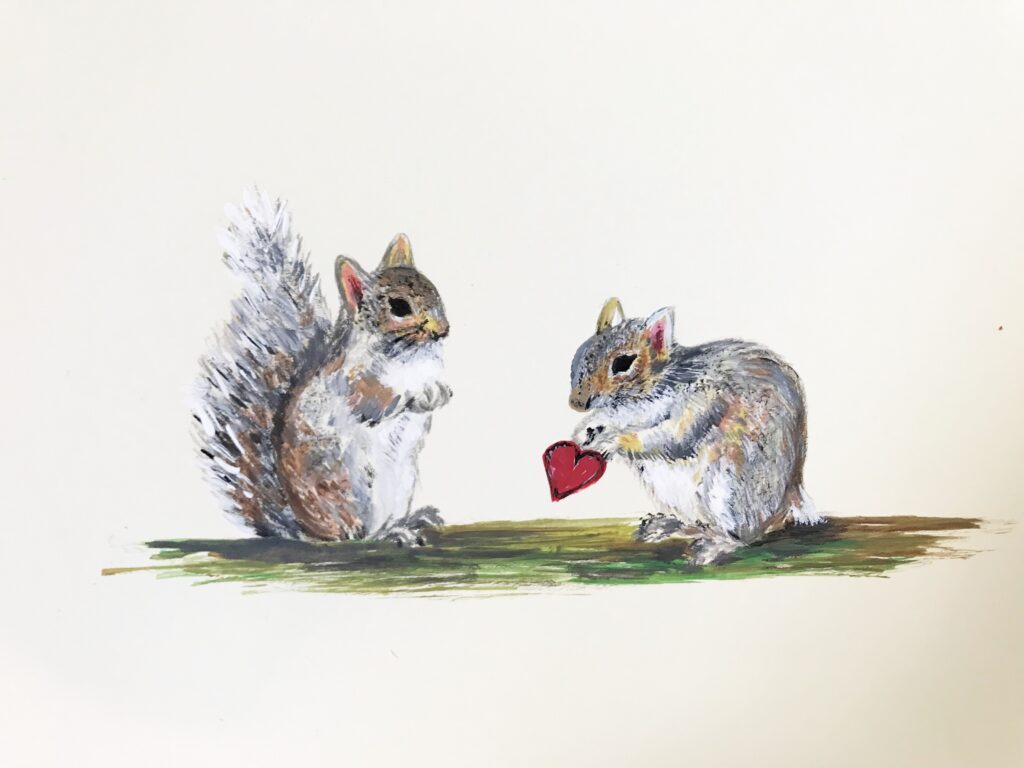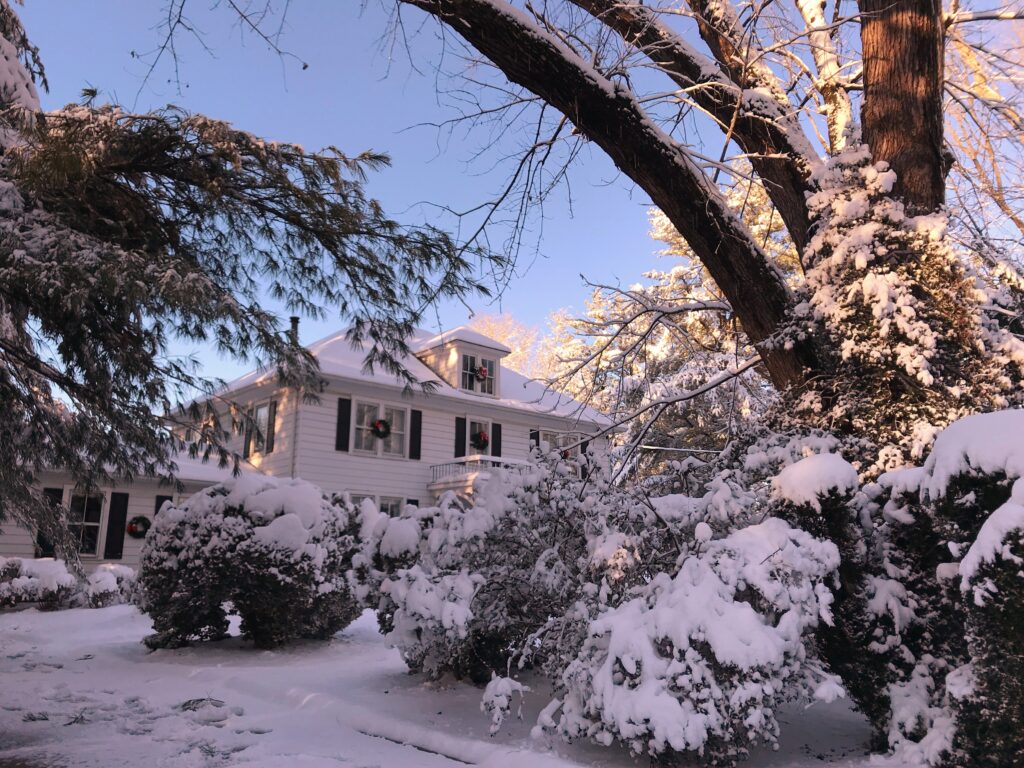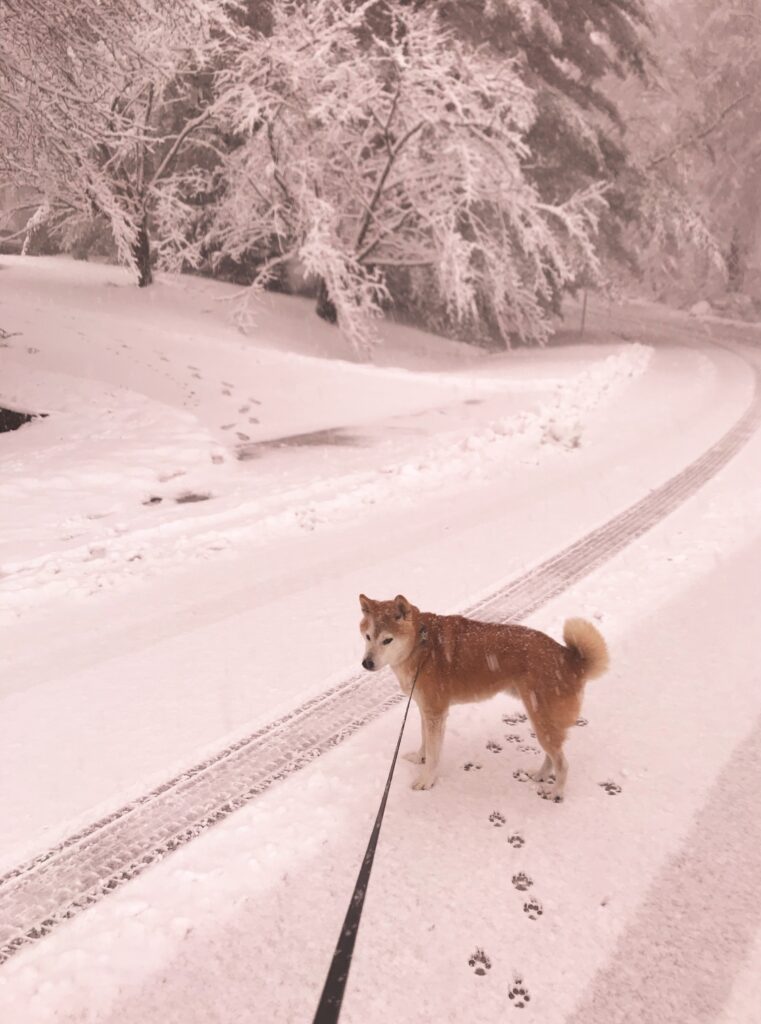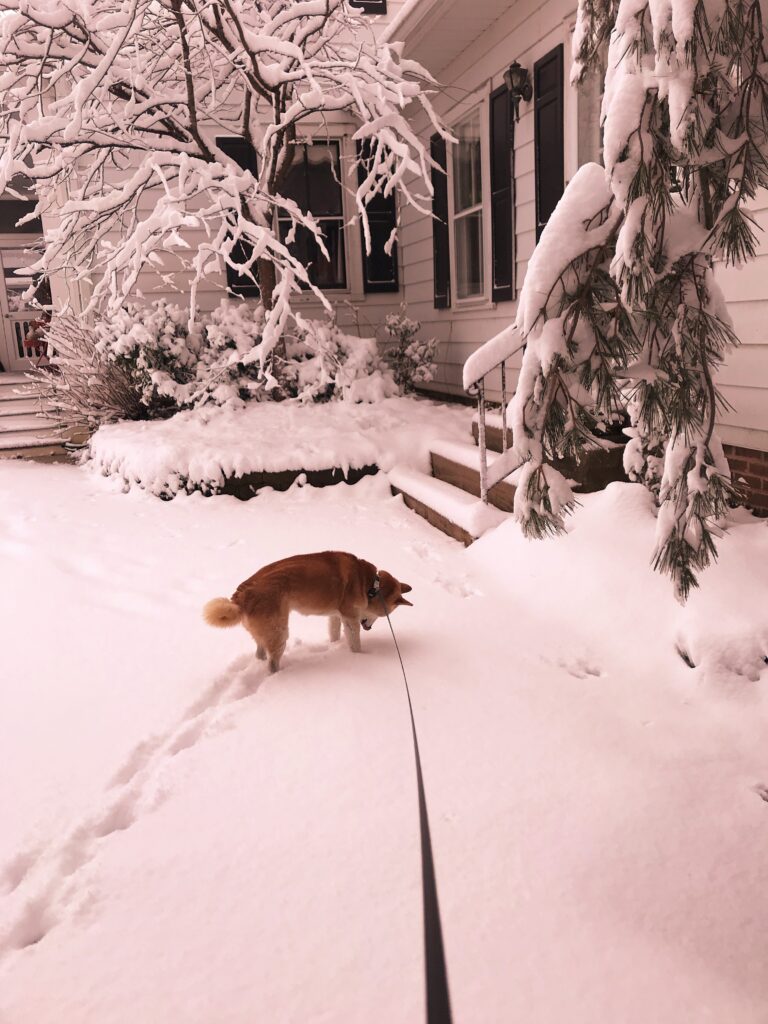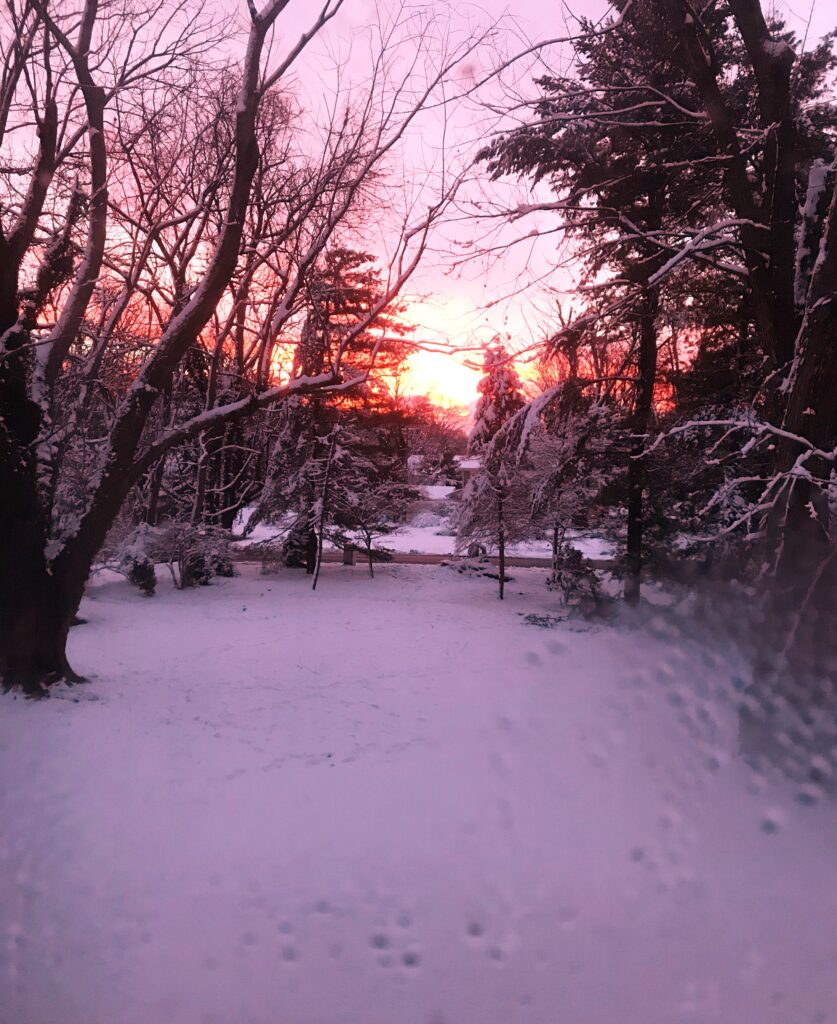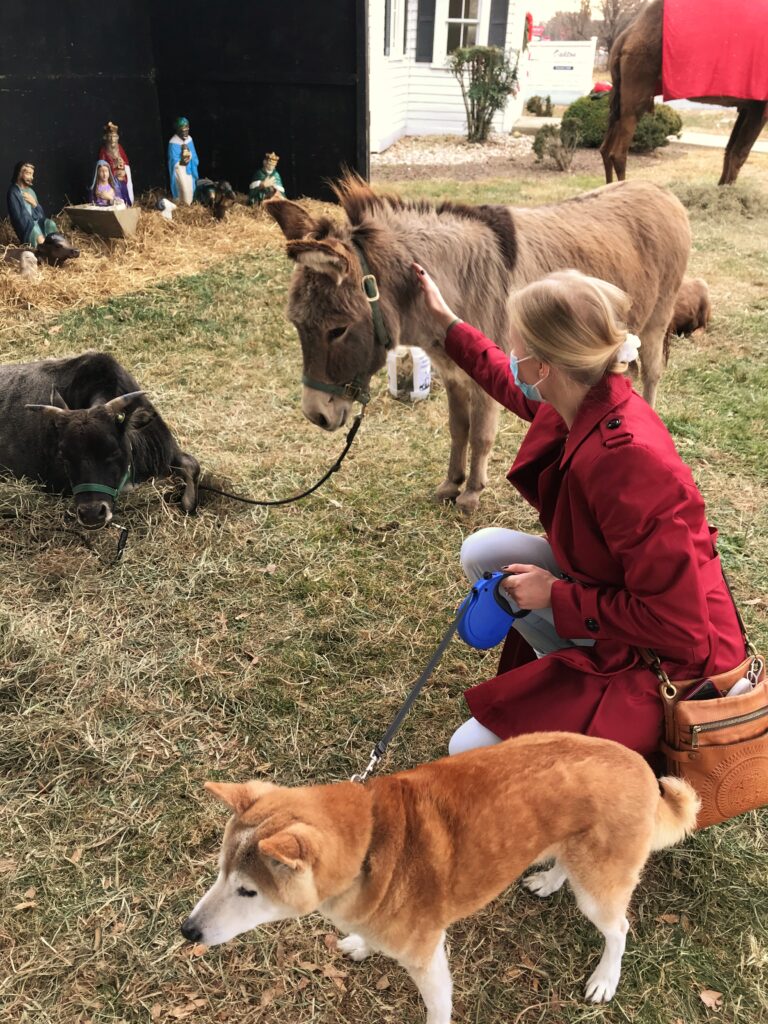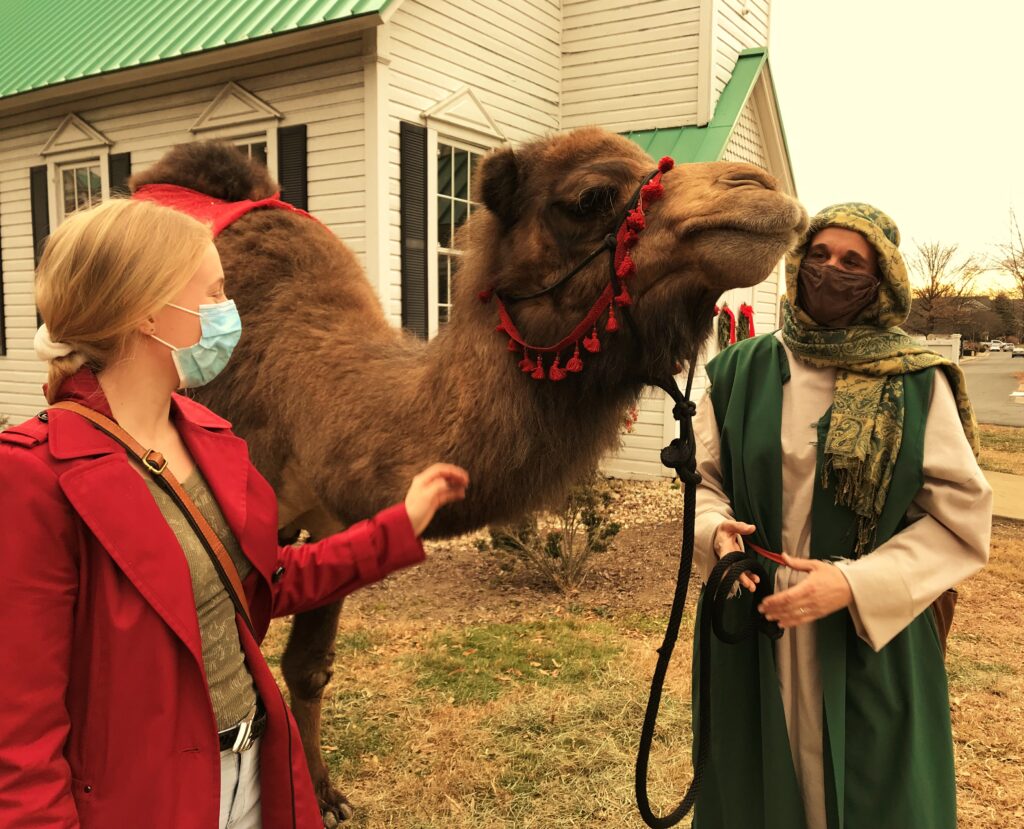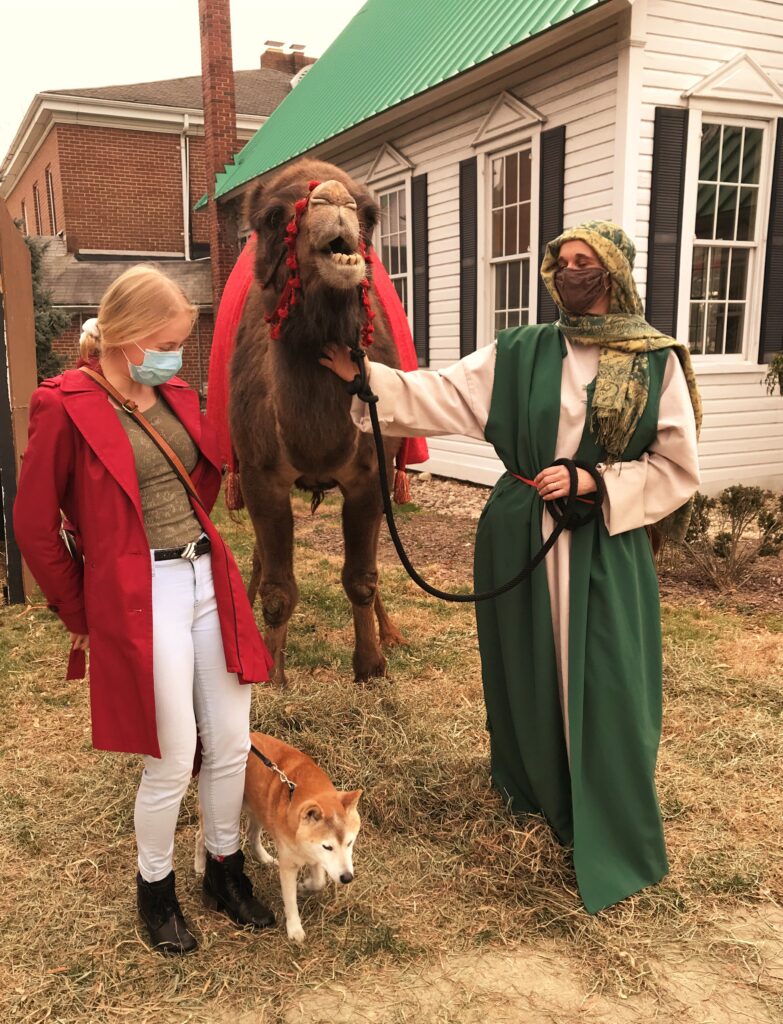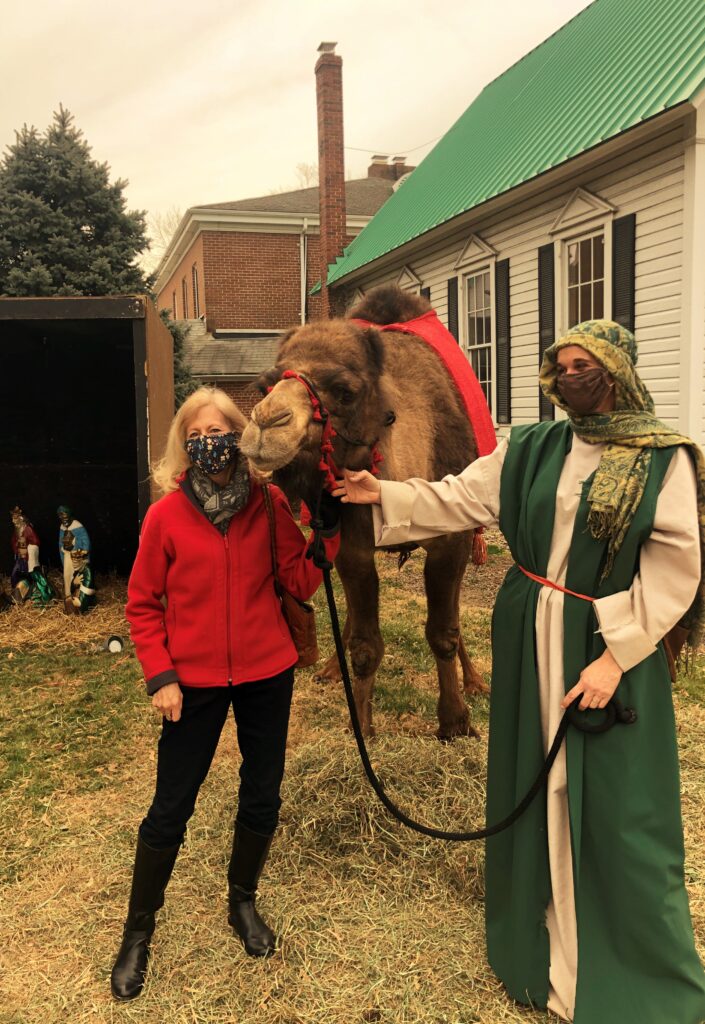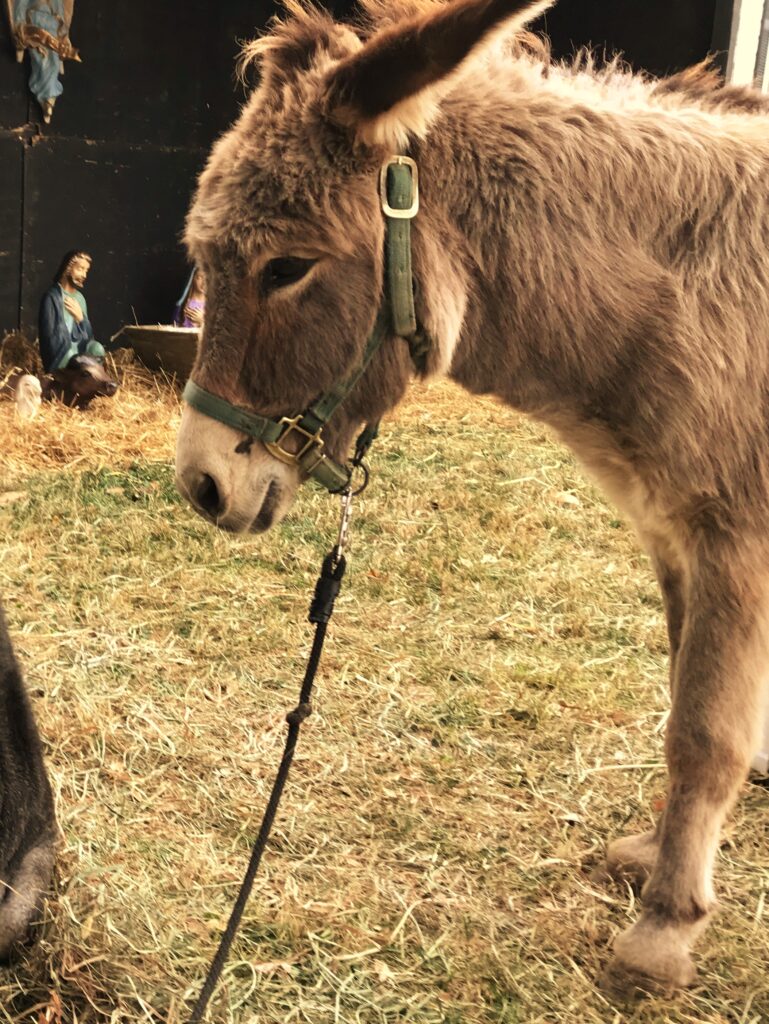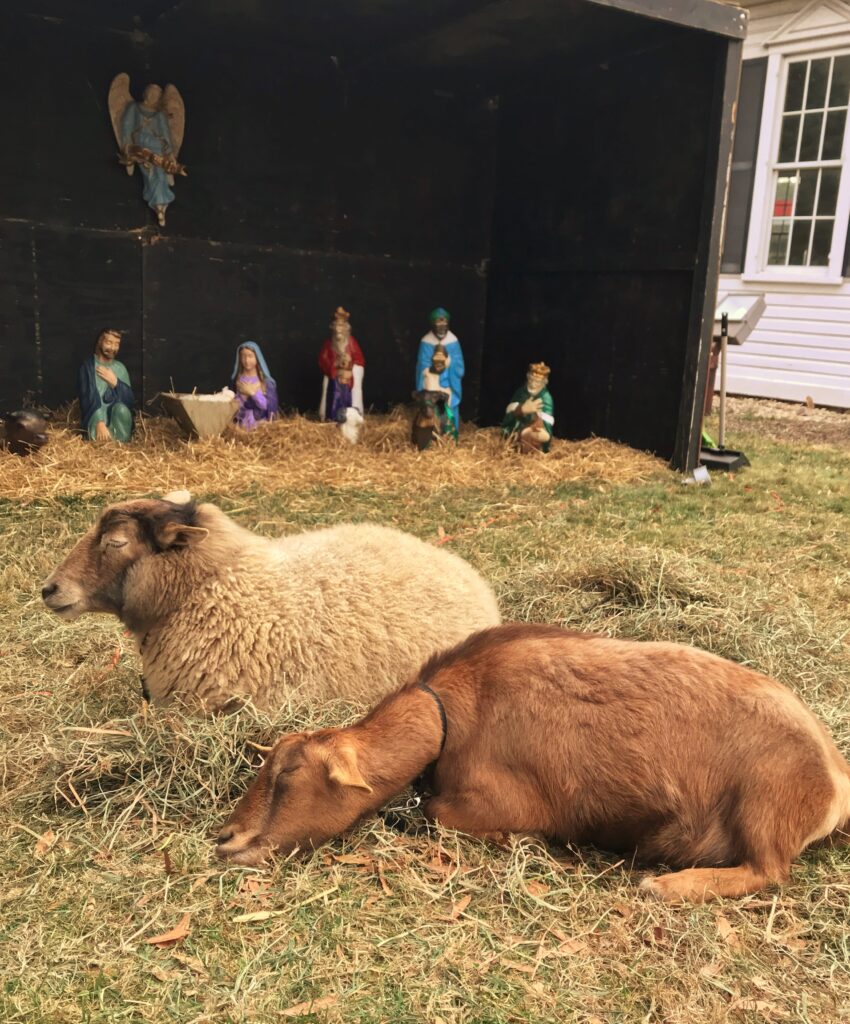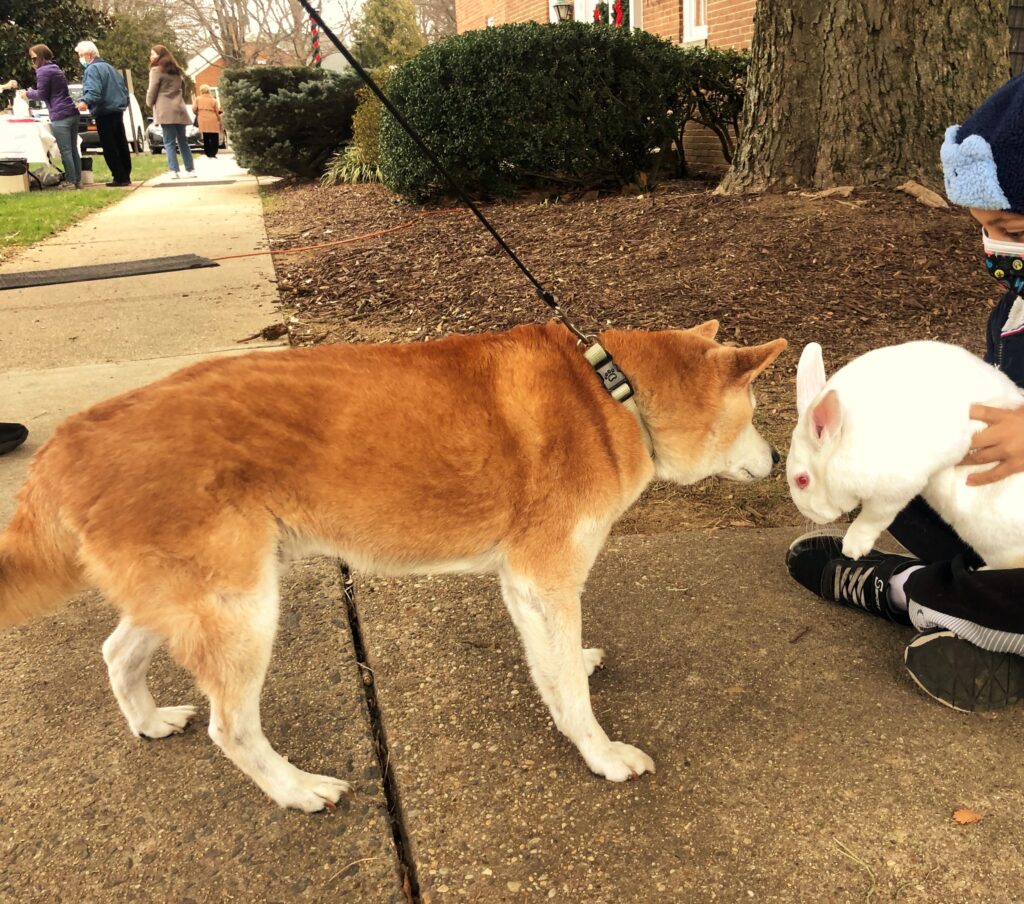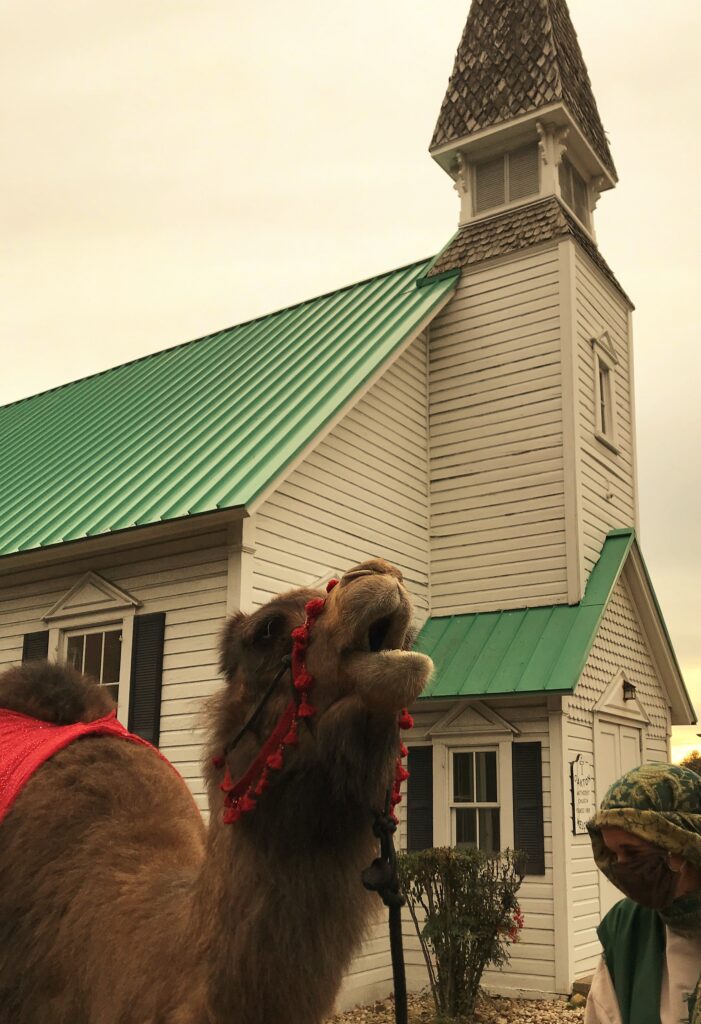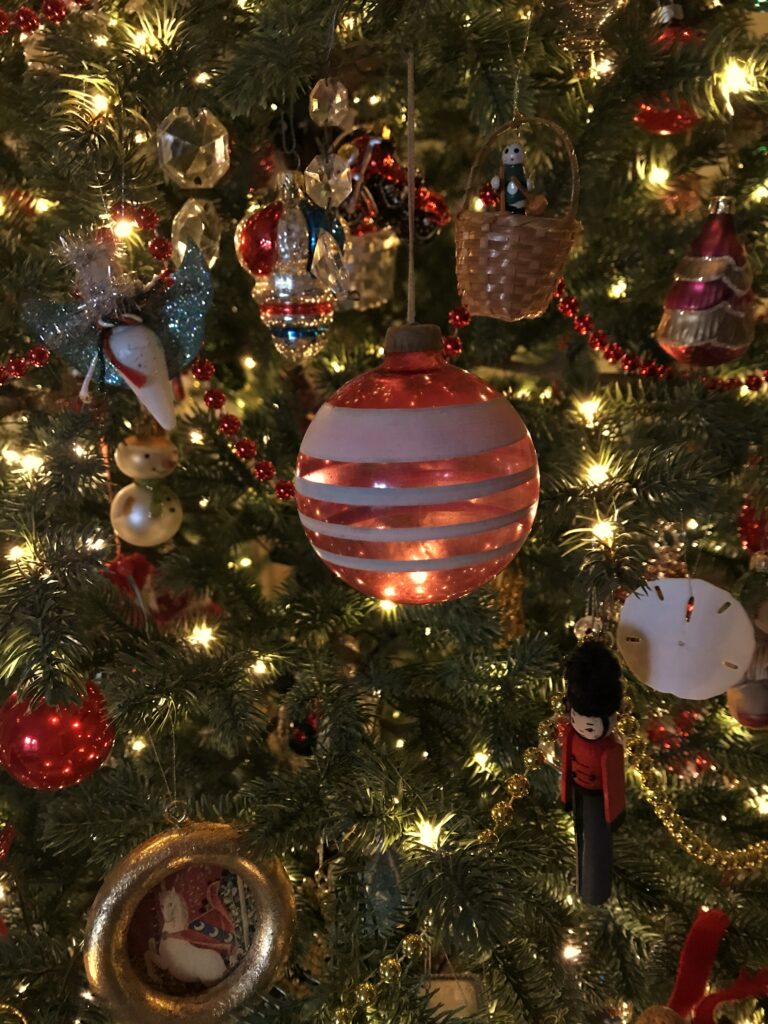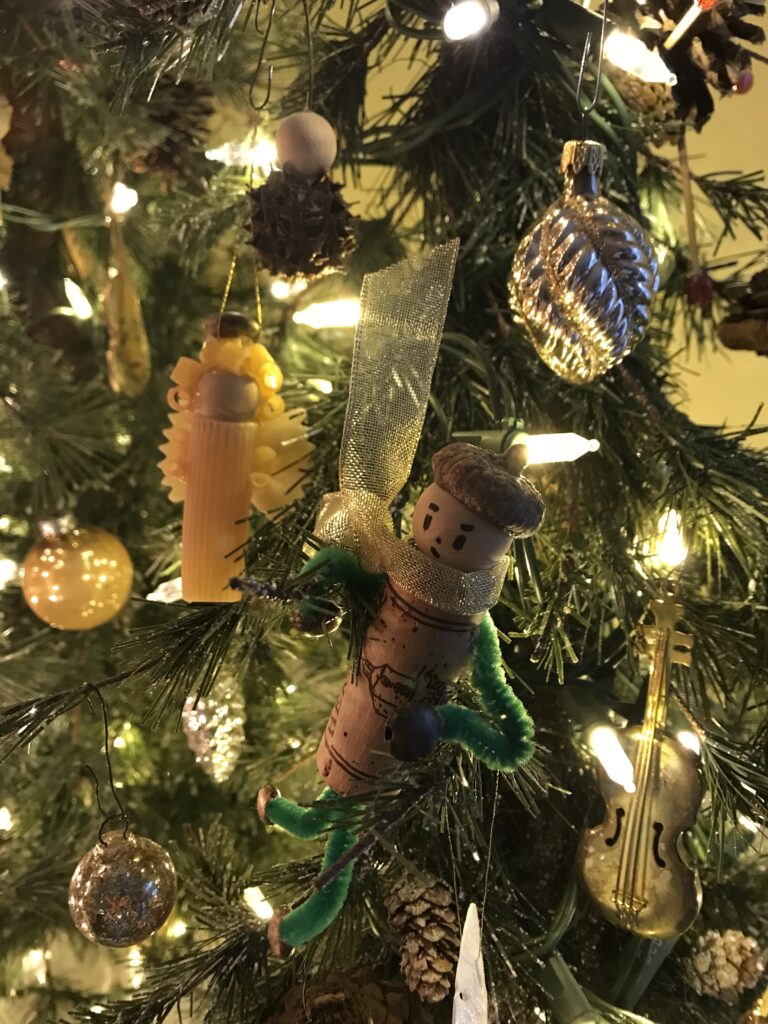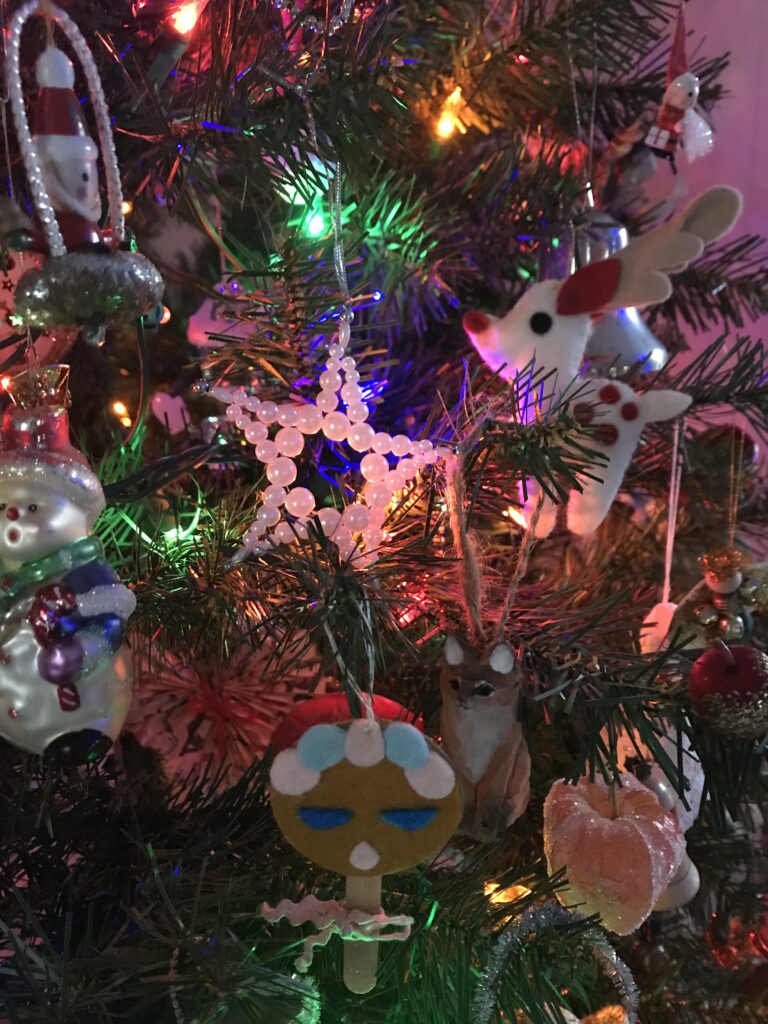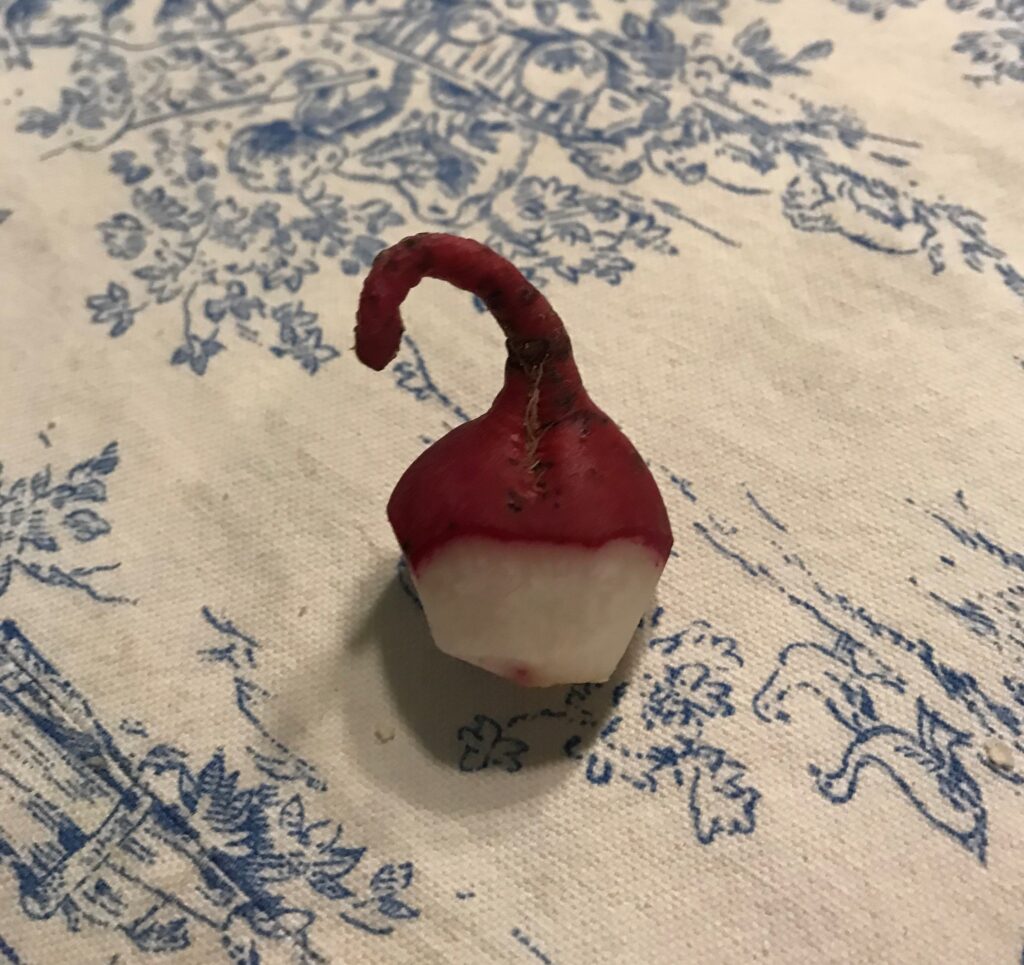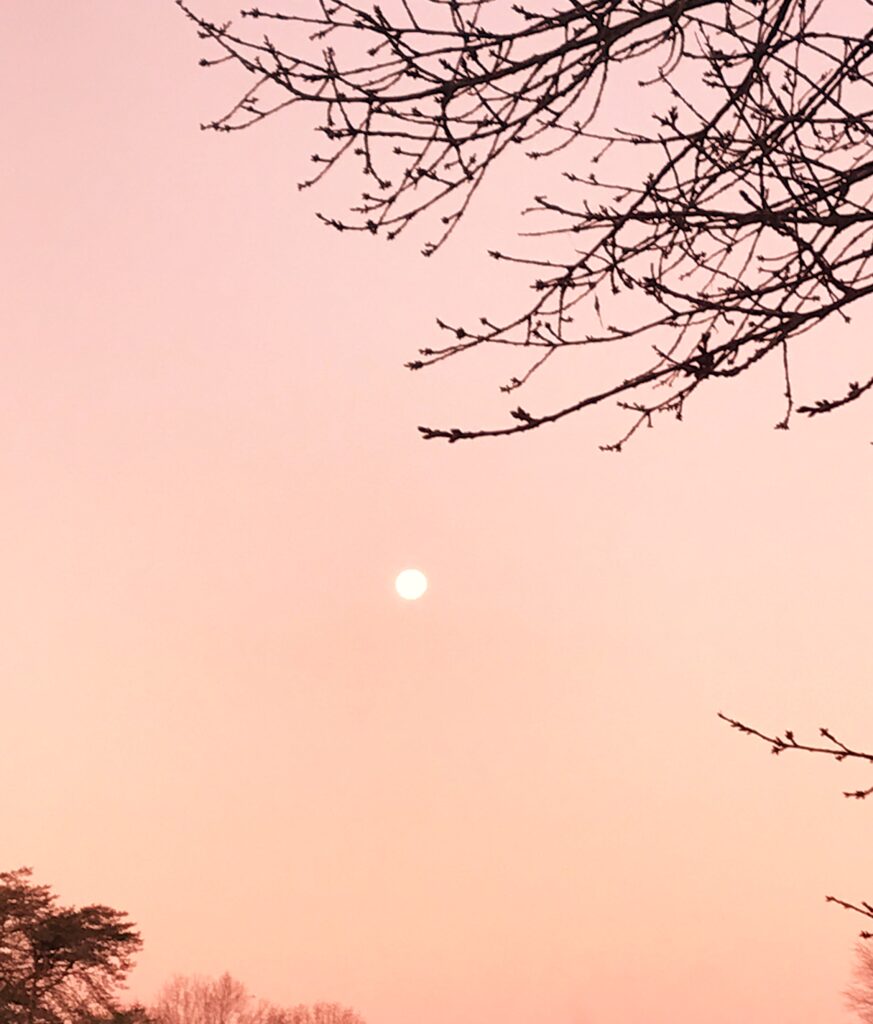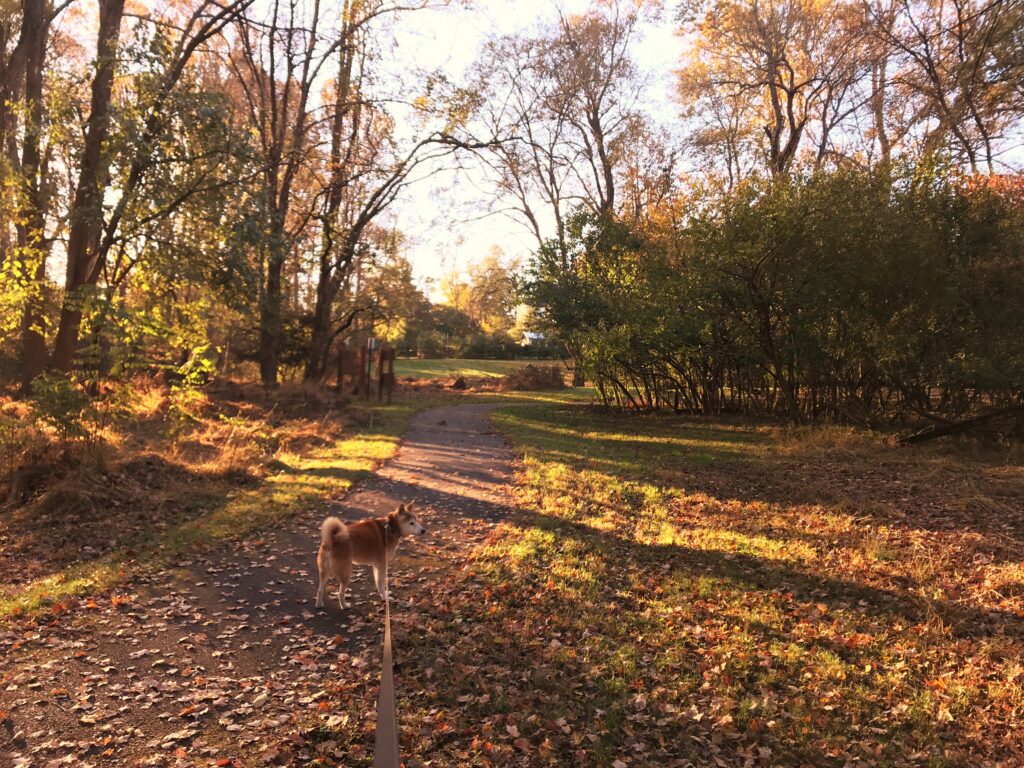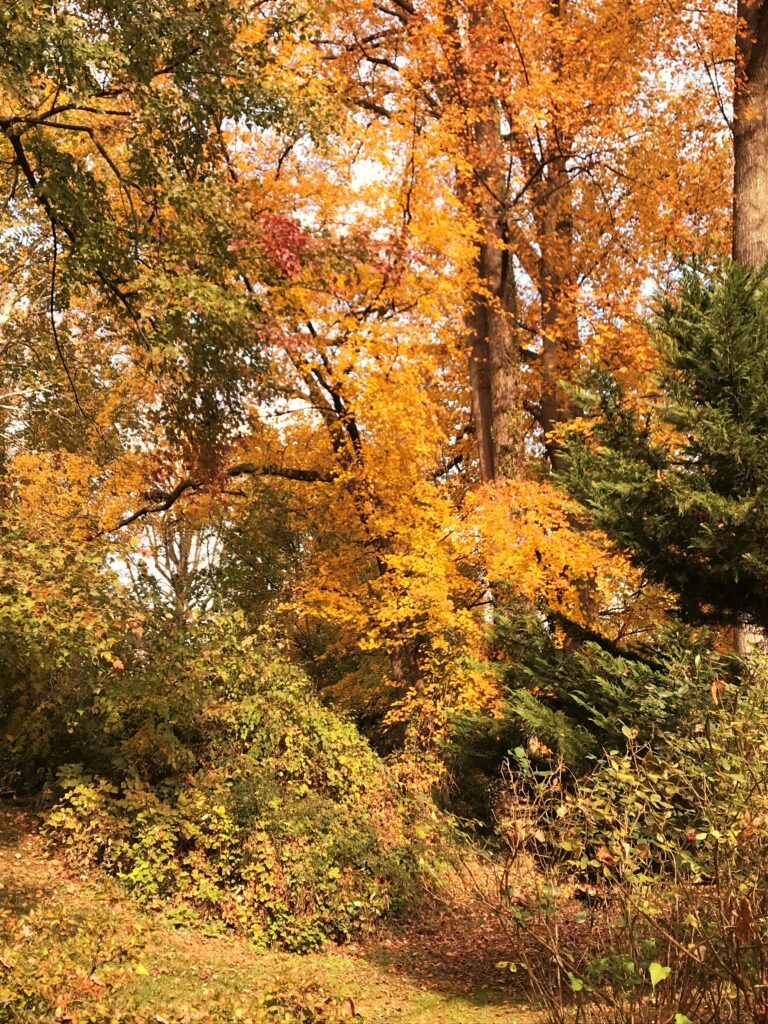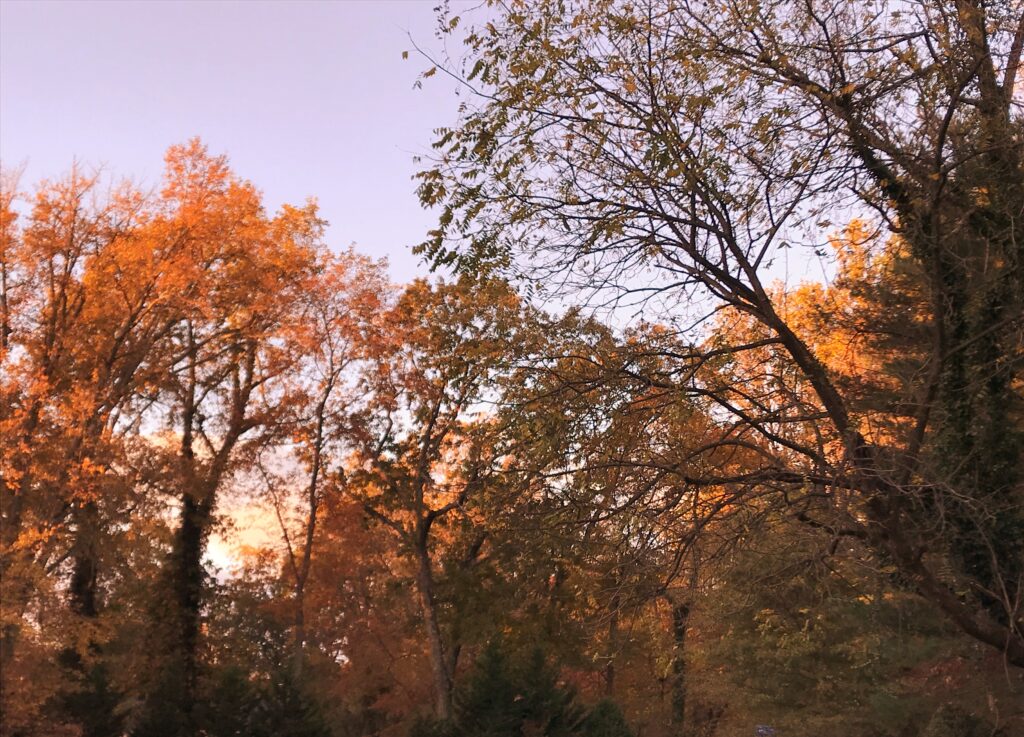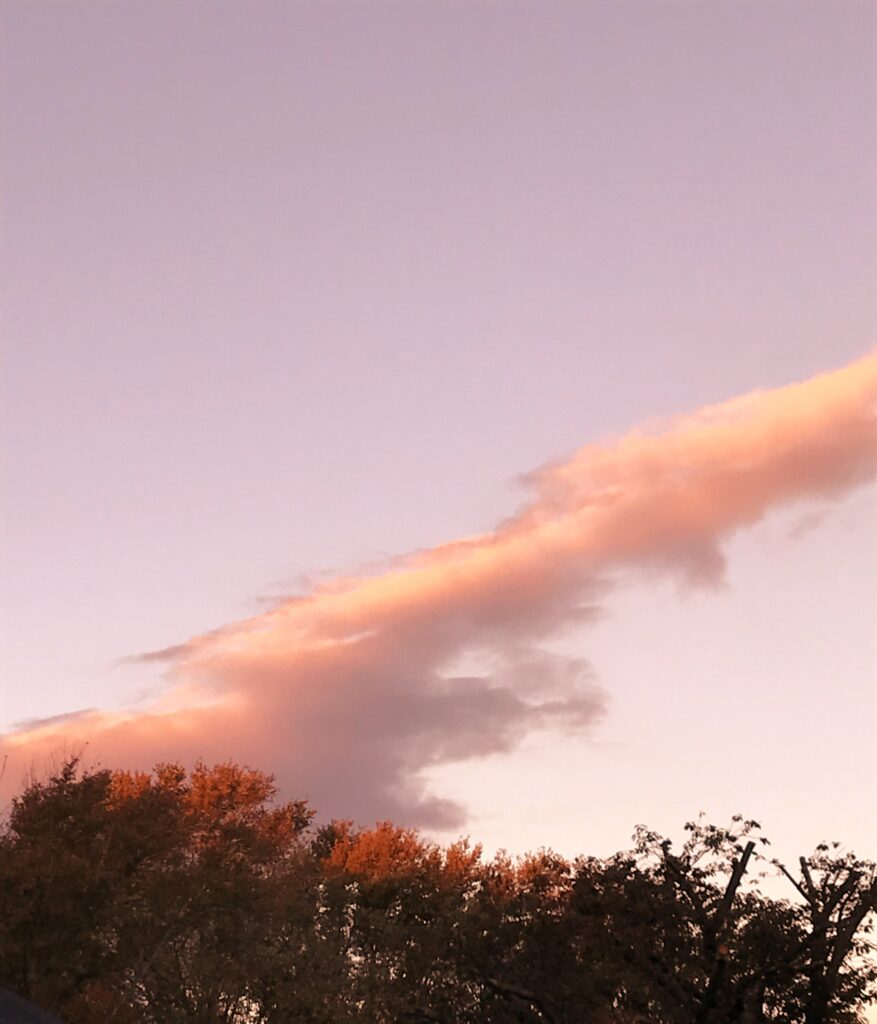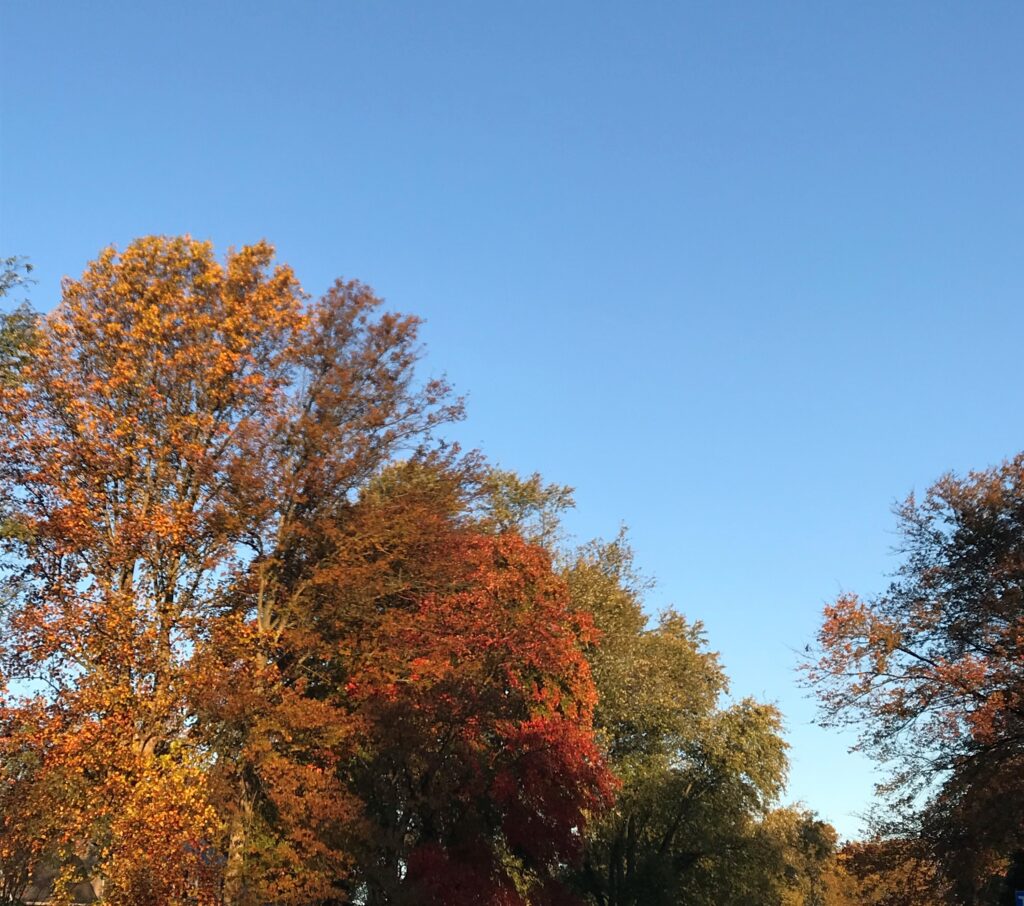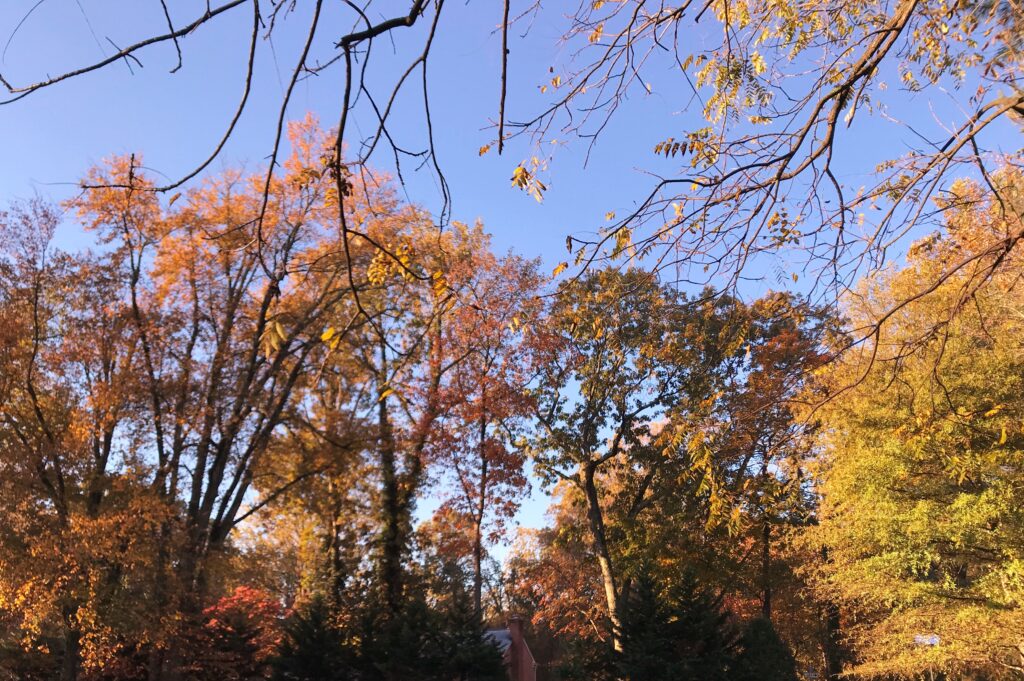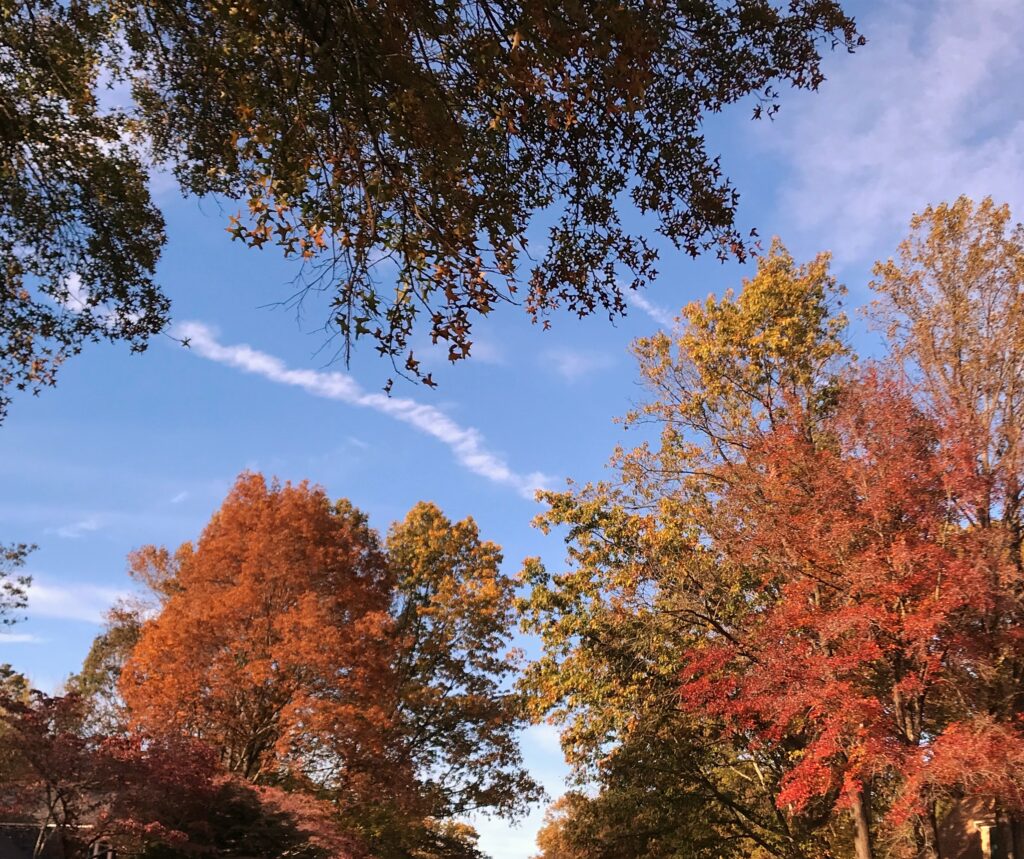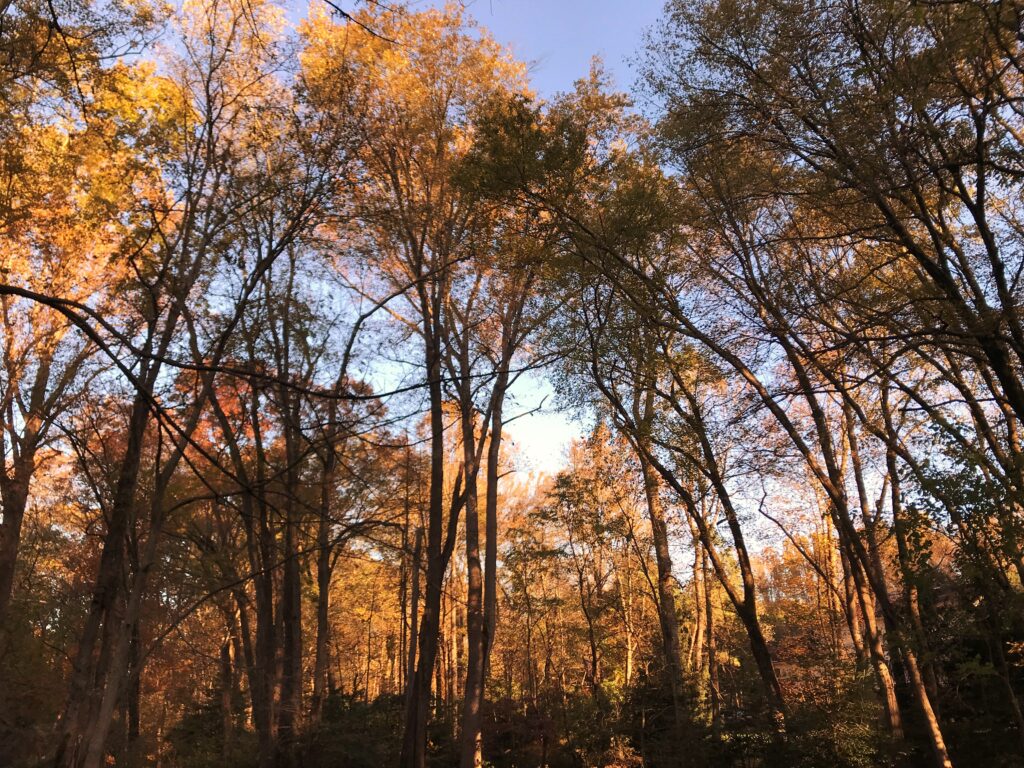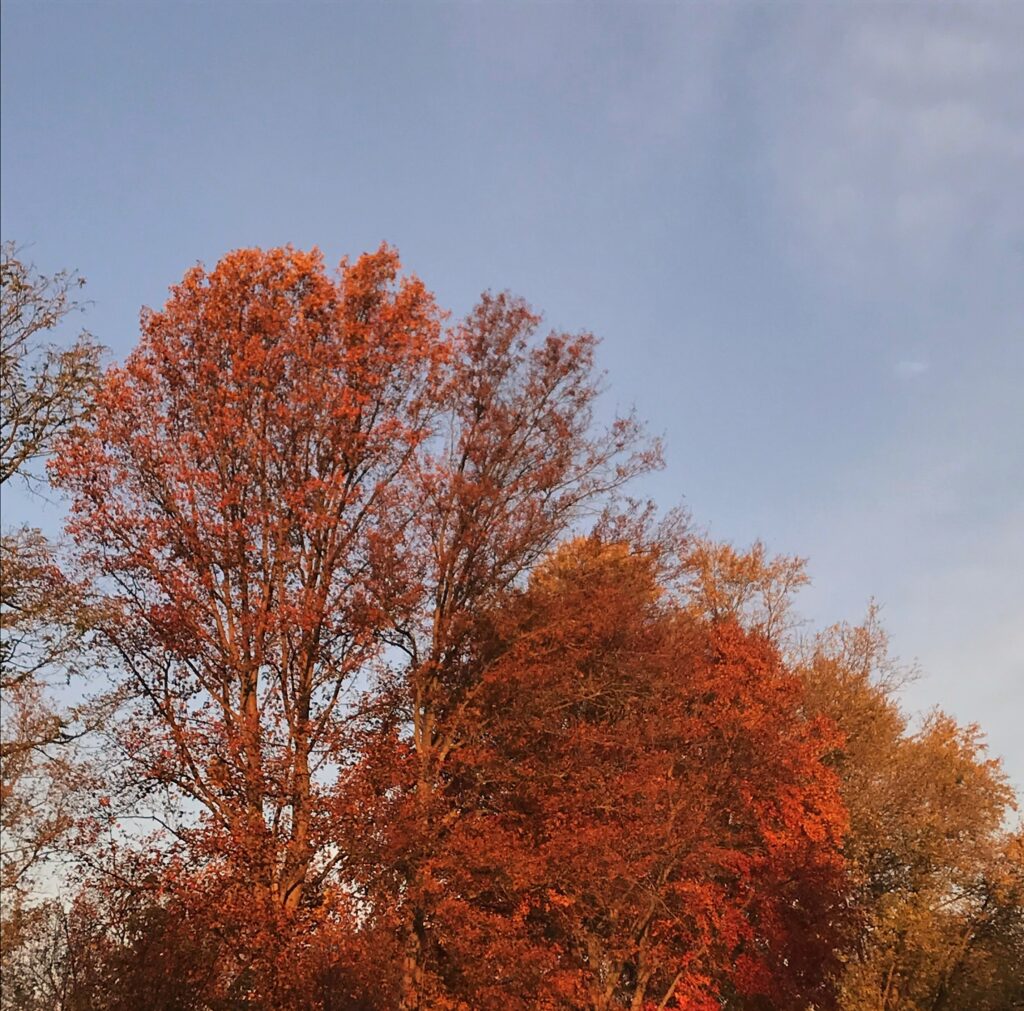All posts by Wildtrumpetvine
Foggy Morning, Foggy Memories
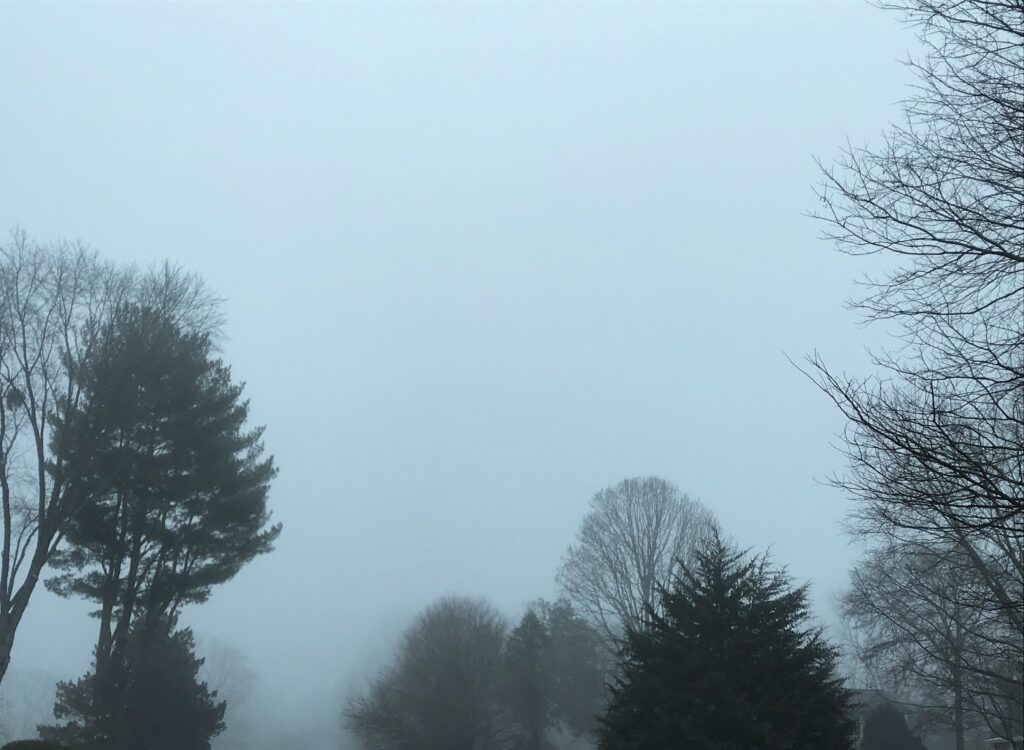
Out with Kiko on a recent damp, cold, foggy morning was like being immersed in a grisaille landscape painting. The world was drained of all color. Branches were inky black against a silvery sky, and distant trees were soft smudges of gray.
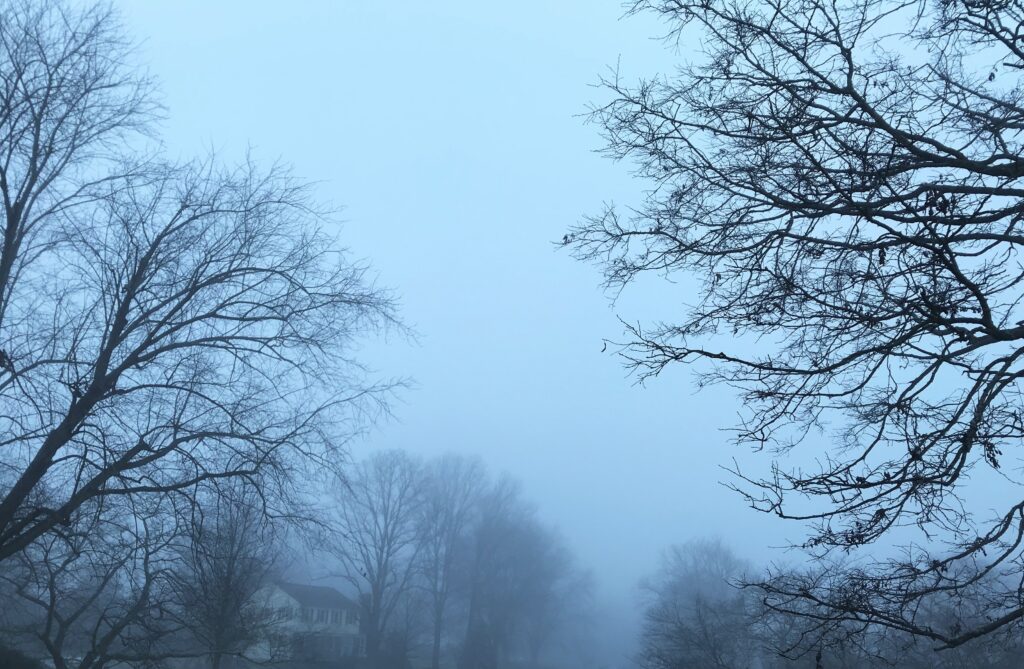
I was reminded of the few months I spent in Cambridge, England as a grad student while researching my dissertation. I remembered standing on the bridge over the River Cam, watching the form of King’s College Chapel slowly materialize through the mist, and realizing that those blurry shapes nearby were cows grazing on the Backs. I recalled the sharp, bone-numbing chill of the wind that blew across the Fens. I will never forget that intense cold of a Cambridge November, which overwhelmed the meager heating system in my rented room in an old house on Panton Street.
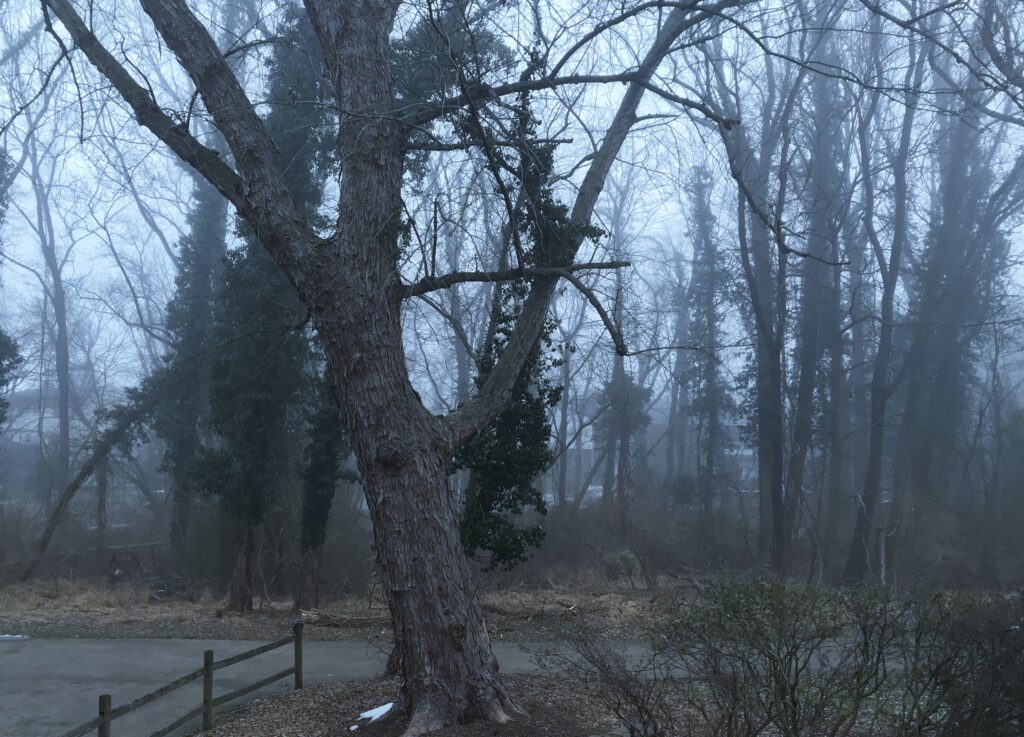
That part of my past is so distant now that sometimes it seems like it no longer belongs to me. Perhaps it’s even more remote because of its contrast with the predominantly home-bound sameness of the last two covid years. Did I really live for a year in England in my twenties? Did I travel in Britain and Europe, examining Gothic illuminated manuscripts in ancient libraries, having adventures and staying in seedy, ramshackle no-star hotels? Was that young woman really me? I have photos to prove it, as well as assorted associated memories. But some experiences, no doubt, cannot be recalled; they’re gone for good. Others can be only glimpsed; they’re in the process of dissolution. And with every passing year, they become more tenuous, wispy and ghost-like, threatened by the fog of time.
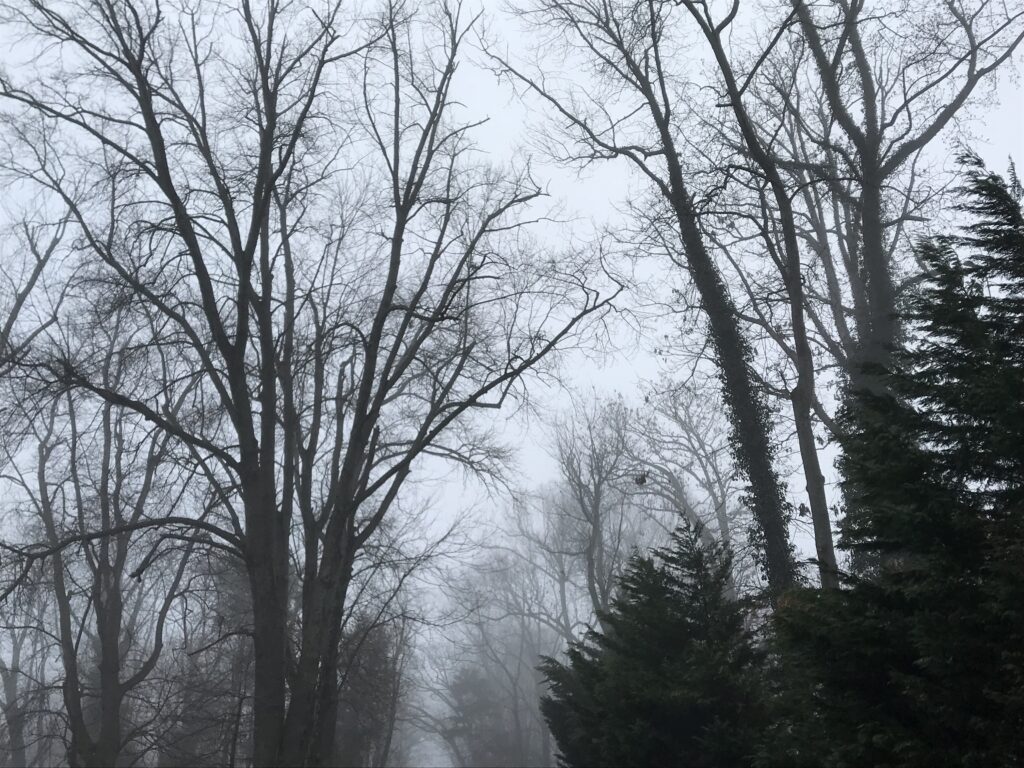
I’m resolving to reclaim that past before it’s lost. This winter I’ll look back on those photos and re-read my dog-eared travel notes. I’ll need help to make sense of them, because my own haphazard archives will be insufficient. I appeal now to those friends who adventured with me during that long-ago year in England. Let’s reminisce and compare memories; together we’ll reassemble portions of some of those old days piece by piece. They’re too precious to be forgotten. There will be missing pieces, of course. And missing companions. Sadly, not all of us have survived. All the more reason to start the process as soon as possible.
A Snowy Start for 2022
The first two days of 2022, here in Northern Virginia, like those at the close of ’21, were damp, gray and mild, with temperatures reaching the mid-60s. There was talk of snow to come, but it seemed highly unlikely. The pattern of dull, sunless days had been established; it was hard to conceive of it ever changing.
But just as predicted, snow began falling in the early-morning darkness of January 3rd, accumulating quickly. It coated the bleak landscape with glistening white frosting that piled up, and up, elegantly and artfully.
Our yard and house soon acquired the Christmas-card aspect they had been missing all during December.
Kiko’s first steps in the snow were tentative and uncertain. Mine were, as well. The older we both get, the more actively I work to avoid a fall. Our morning walk was slow and halting, as I tried to keep him off the many icy spots on the road.
Once we made it back to the fresh snow near the house, he embraced it gleefully. Seeming to regain his youth, he pounced like a fox through the soft powder.
At sunrise and sunset, sky and snow tend to take on a luminous pink glow.
On the night of January 6th, our old house gleamed as white as the snow. Now that all twelve days of Christmas have come and gone, our exterior illumination is history. I’m always sad to hear that final click of the lights as they go dark, not to shine again for another eleven months. I’ll keep the decorated trees up for a while. Their soft light will be a much-needed comfort in the winter darkness to come. For now, the brightness of the snow, visible through the windows, provides some extra consolation.
I can’t help thinking about how much our daughter would have appreciated being at home for this particularly lovely snow. A few years ago, she would have reveled in the luxury of a few days off school, with time to savor the glories of the surrounding winter wonderland. But she returned to Maryland on Sunday, and awoke the next morning, as we did, to the blanket of white. We swapped snow pictures. Her days of simply cavorting in the snow on a weekday are largely in the past. The demands of the job were calling, a job not well-suited to remote working. Her car, in the uncovered garage, would have to be dug out. It’s too bad that no one thought to send her back to her apartment with a snow shovel. She used a dust pan instead.
But hey, I’m impressed. I didn’t know our girl owned a dust pan. Clearly, she’s an adult now.
Return of the Live Nativity
The animals were back, after last year’s absence, at our church’s live nativity this Christmas Eve. Joining us again were a burro, a small ox, a sheep, a goat, and, of course, a camel. Because of ongoing covid precautions, no human actors were featured in the tableau. . .
. . .except for camel’s handler. Delilah was the camel on duty this year; her colleague Samson was engaged elsewhere. She was as friendly and patient as we’ve come to expect her to be.
Kiko enjoys the live nativity primarily for the multiplicity of smells it affords. The animals responsible for them are of less interest. Our dog rarely looks up, and the camel’s great height puts her well out of Kiko’s radar. He seems oblivious to her presence.
Delilah isn’t especially curious about Kiko, either, but she never seems to tire of posing for photos with a parade of curious onlookers. If encouraged, she offers a welcoming nuzzle.
The furry little donkey has a cuteness quotient that rivals any dog’s.
Evidently the group had a busy holiday schedule. The sheep was drowsy, and the goat was sleeping soundly, until Kiko got close and woke him. The goat was startled, and Kiko was even more so.
One family brought along their big white bunny, whom they eagerly introduced to Kiko. The rabbit didn’t appear enthusiastic about the meeting; his air was more akin to that of a sacrificial victim. Our dog had never seen a bunny before, and he wasn’t sure what to make of this new creature. Should he consider it an equal, as he does the sheep, goat and donkey? Or is it more like a squirrel, something to be pursued? After several encounters, he seemed possibly inclined to think it was the latter. At that point, we made sure he kept some distance from the bunny, who was, no doubt, relieved.
Delilah opens her mouth for a big yawn. Her shift is coming to a close; it’s nearly time to get back into the trailer for the next gig. She wishes everyone a lovely Christmas Eve and a merry Christmas!
On Winter Solstice, A Need for Christmas light
This shortest day of the year has been gray and bitterly cold here in the suburbs of our nation’s capital. I spent a good part of the afternoon out with my elderly dog, making halting progress around the perimeter of a grocery store parking lot. One of the abiding pleasures of Kiko’s old age is a ride and a walk, followed by a snooze in the car while I shop. Having underestimated the chilling effect of the breeze, and not expecting to be out for very long, I was inadequately dressed. Every leaf and every square inch of sidewalk seemed to be calling out to my dog’s discerning nose. He sniffed, and sniffed, and continued to sniff some more. Yet there was no resolution. Never a suggestion of a lifted leg, nor even the briefest of squats. An unlimited number of intriguing smells, yet none deserving of Kiko’s unique canine signature. We made our usual circuit and then continued on around the assisted living facility. Still nothing, so I put him back in the car and headed into the grocery, my fingers numb, my patience tried, my temper short. I knew that once we got home, Kiko would need another outing.
Sure enough, as I was dealing with the groceries, Kiko strolled confidently into the kitchen and pawed at the door. On his placid, expressionless face, I read smug entitlement. I love this dog, I thought, but why? By then it was dark, and even colder, but I bundled up as if for an arctic expedition. Fortunately Kiko remembered the reason for the walk, and we were back quickly.
Back into the indoor warmth and the cheerful, comforting lights that currently adorn nearly every room of our house.
On this first day of winter, and on the short, dark days ahead, I’ve found that I need the soft, glowing lights of Christmas like I need food and water. Like my old dog needs his slow, rambling walks. The lights of Christmas are a heartening reminder that in our chaotic, angry, crazy world, God’s love endures.
The light shines in the darkness, and the darkness has not overcome it.
–The Gospel of John, 1:5
‘Tis the Season?
Christmas is five days away. Every year around this point, I ask myself: how can this be? How can Christmas be upon us? But this year, more than ever, time seems slippery, unreliable, prone to eccentricity. Yesterday seems like a month ago, yet wasn’t Halloween just last week? Is it because of my advanced age? Is it because of sudden and broad temperature fluctuations? In a typical seven-day span, here in Northern Virginia, we experience weather appropriate for all four seasons, sometimes in a single day. Is it because we’re approaching our third Covid winter, and the weeks and months are draped in a veil of sameness?
It’s certainly not because I’ve neglected the usual Christmas prep. I haven’t, and it’s kept me too busy to write. The evidence of the season is all around me, but still, this mid-December has an air of unreality. Something just seems off.
After further reflection, I think it may be this: the back-of-my-mind awareness that our daughter will no longer be joining us for an extended winter break. The Christmas season, in recent years, has begun in earnest for me with her arrival home from college. Last year, it started with her final online exam, as she was already here. I think what I’m missing now is the anticipation of having her back with us for about a month. That extra spark of excitement is absent.
At this realization, I had a mental pep talk with myself. Our daughter will be coming home soon, for about a week. She can’t stay longer because she’s gainfully and happily employed. (I’ve never held a job that ticked both boxes.) She’s embarked on a career that relies upon her training. This is why she went to college. At least it’s why the time, trouble and expense of college can be justified. All those demanding classes in aerospace engineering and astronomy are being put to good use. And while she’s a Maryland resident now, she’s closer to home than she was in Charlottesville. When she first began applying for jobs, my husband and I both feared that she’d find it necessary to move to the West Coast. In the rare absence of traffic, she can drive home in about an hour.
So I’m a lucky mama. We should see our dear daughter in two days. And then Christmas Vacation will officially begin.
As my mother reminds me, having recently watched a PBS show about the medieval origins of the twelve days of Christmas, December 25 is only the first day of the festive season. I’ve got plenty of time to get that spark of excitement back. In fact, I’m starting to feel it already.
The spirit of the season is popping up in unexpected places. Here, for example, is a radish that resembles a little head in a pointed elf cap.
The halls have been decked. It’s time to savor the joy of Christmas.
Thanksgiving 2021
For The Beauty of The Earth
This fall’s brilliant colors and bright sunshine have kept the words of this old familiar hymn very much on my mind. As Thanksgiving approaches, they’re even more appropriate.
For the beauty of the earth,
for the glory of the skies,
for the love which from our birth
over and around us lies;
Lord of all, to thee we raise
this our hymn of grateful praise.
For The Beauty of the Earth, Words by Folliot Pierpoint, 1864, Music by Conrad Kocher, 1838
A Pilot in the Family, on Veterans Day, 2021

Thank you, this Veterans’ Day to all those who put their lives on the line to defend our country and our freedom. My father is the first veteran in our family that I typically think of on this day set aside to honor those who’ve served. My Uncle Bill is the second. Daddy was stationed in Regensburg, Germany, with the U.S. Army Occupational Forces following World War II. My mother’s brother, Bill, enlisted at sixteen and served as a Frogman in the Pacific.
While looking for a photo of Daddy or Uncle Bill to post on Veterans’ Day, I came across a picture of another family member in a military uniform. I don’t recall my father ever mentioning his distant cousin, Hunter, above. According to the inscription on the back of the photo, in Daddy’s neat handwriting, Hunter was a Lieutenant in the Air Service during World War I. He was born August 30, 1895 in Jane Lew, West Virginia, which is also my grandmother’s home town. He survived the war, and died at age sixty-five on May 9, 1960 in Martinsburg, West Virginia. He’s buried in Arlington Cemetery. The photo bears no date, but it must have been taken in 1917 or ’18, when he was twenty-two or twenty-three. When he was my daughter’s age.
I learned from another cousin that Hunter was the son of my great-grandmother’s brother, which makes him my grandmother’s first cousin. He was married in 1922 to a woman named Marion, and together they had at least one child, a son. I wish we knew more about Hunter’s experiences during the war. I wish I could read some of his letters home, as we’ve read my Uncle Bill’s. I wish we knew more about Hunter’s later years, as well. I hope he has grandchildren now keeping his memory alive. I hope they have photos that document other notable stages in their grandfather’s life. But I’m grateful that at least I have this lone visual record, this window into Hunter’s young adulthood, when he was a dashing pilot in jodhpurs and goggles, striking a jaunty pose before climbing into his plane to do his patriotic duty. Thank you, cousin Hunter, for your youthful confidence and courage. I hope it stood you in good stead throughout your life.
Halloween 2021

The last time our daughter was home for Halloween was in 2017, her senior year in high school. Her return for the recent holiday weekend therefore seemed extra special. Slim was eager to see our daughter, as well. He recognized her as his ideal partner in preparing for all things Halloween. She is nearly as big a fan of the day as he is. Ever since she was a toddler, Halloween anticipation has begun for her in the summer. (See Friendly Ghosts of Halloweens Past, October 2013.)
In 2020, because of Covid, young parents in our neighborhood organized a Halloween parade, with all trick-or-treating outside. The kids progressed from one end of the neighborhood to the other, to tables set up by families in front of their homes. It worked so well and was so enjoyable that they decided to do it again this year. I liked it because it made it easier to appreciate the costumes and gave more time to chat with kids and their parents.
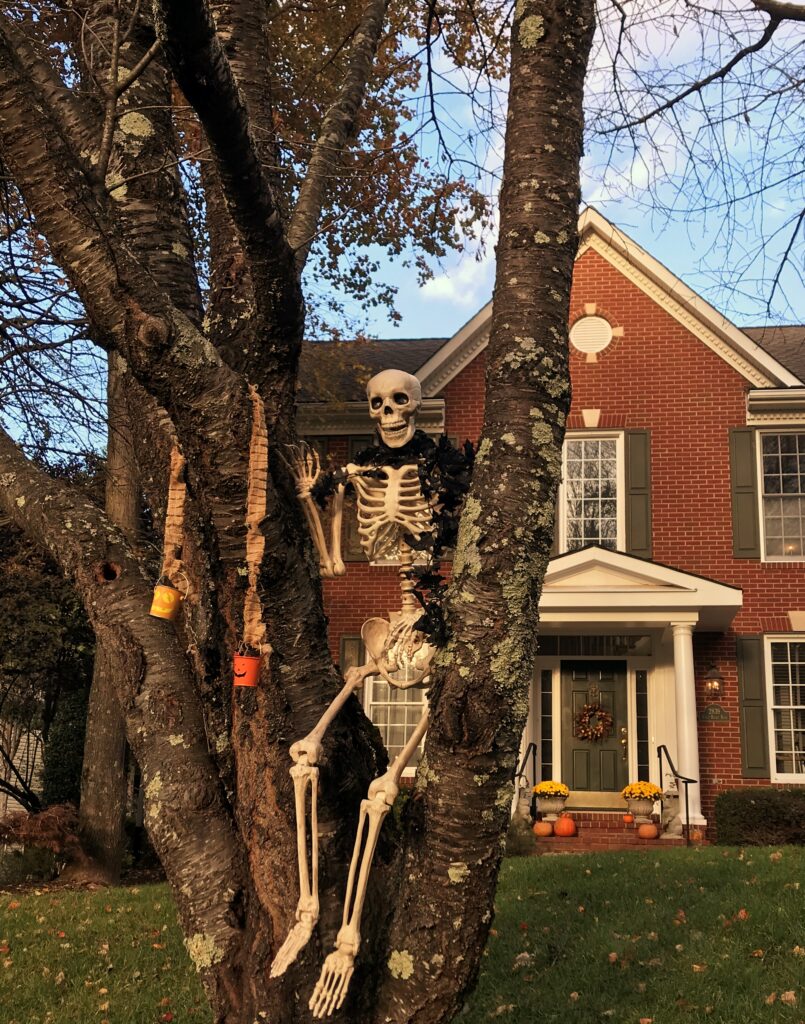
Our daughter was determined to make our Halloween display as thorough as possible. Slim was equally zealous, of course. Together, they hauled out all the old, mostly homemade decorations that D recalls fondly from her childhood: Fred, the stuffed dummy, the tombstone and graveyard fencing, various skulls and bones, jack-o’-lantern votives, spiders and spiderwebs. They festooned our tables for treats in appropriately witchy garb. They set up the fog machine and an outdoor speaker for projecting spooky sounds. They rolled out the love seats from the garage so we could be comfortably seated during the parade. This persuaded even my mother to join us. When we began to see the children approaching, Slim climbed up in a cherry tree, and D, wearing the gorilla costume that we just happen to have, hid herself from view.
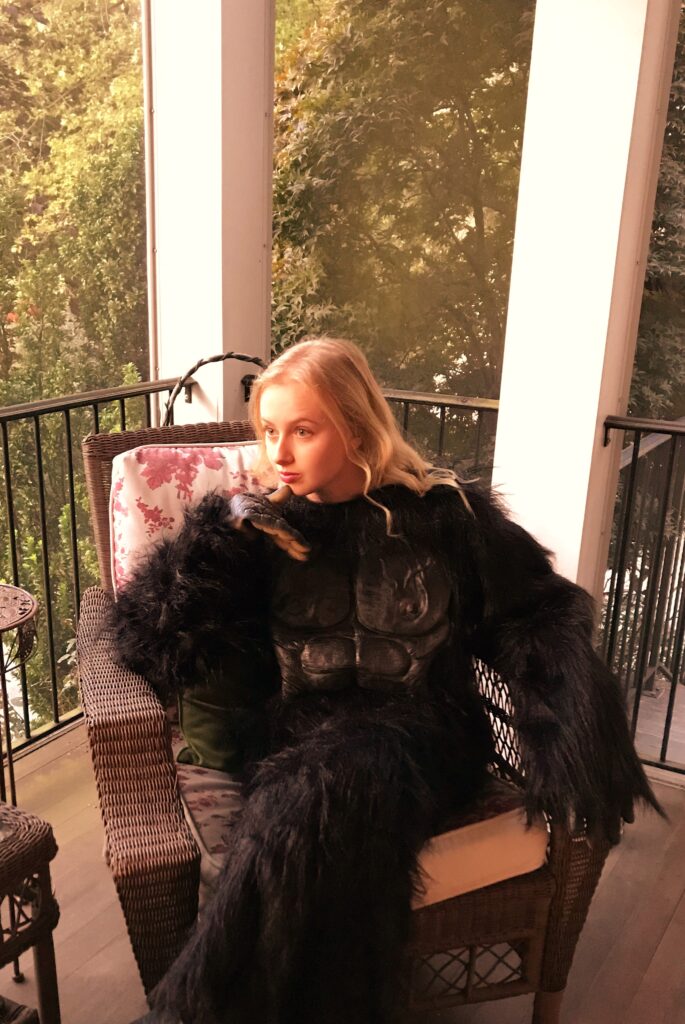
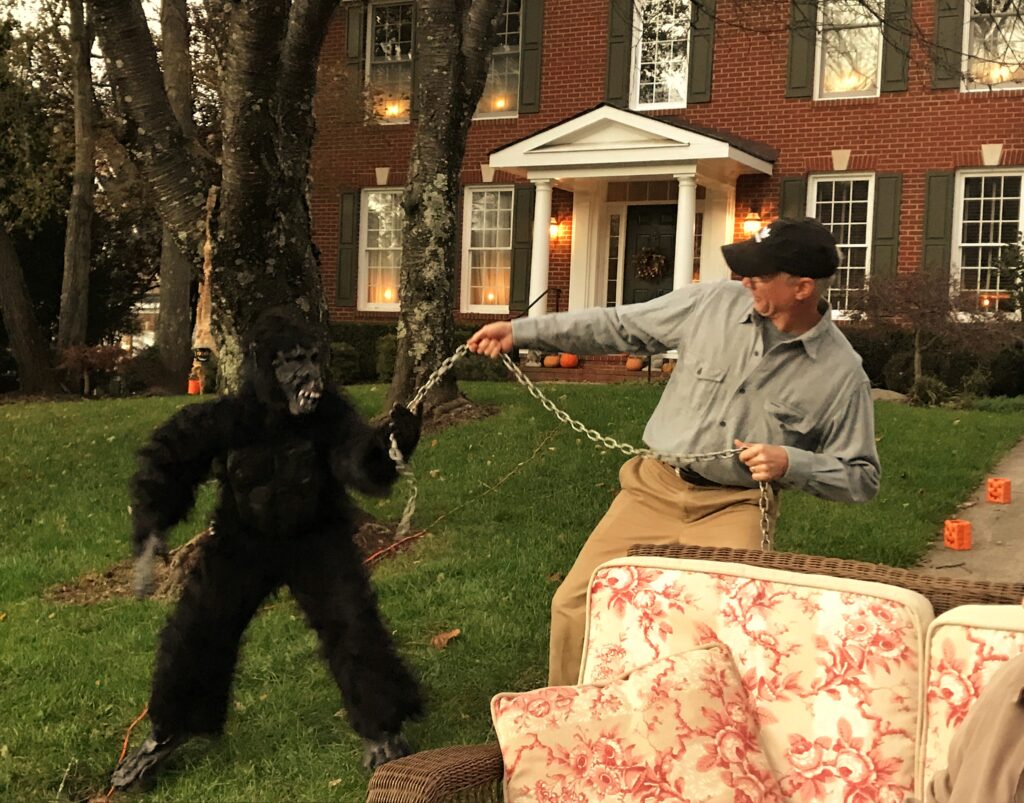
As each group of children chose their treats, my husband, holding a heavy chain, would ask, “Has anyone seen my pet gorilla?” Then D would pop up from behind the love seat and jump around. The performance was well-received, usually with genuine surprise. No one was overly frightened, which was as intended, but one little boy asked his mother to remain close by his side as he got his candy. Several trick-or-treaters, and possibly one parent, wearing an inflatable T-Rex costume, engaged in high-spirited dance-offs with the gorilla.

Thanks to our friendly neighborhood, the parade, to the presence of Slim and our daughter, this Halloween was one of the happiest I can remember. It was rewarding to see just how many children live among us. We were impressed by the innovative costumes, on both kids and adults. How satisfying it was to see neighbors out socializing as they provided treats. As Slim likes to remind us, Halloween has evolved from an ancient Celtic harvest festival into a day when we affirm our common humanity through a love of sugar. It’s a day to welcome back, unapologetically, the child that abides within us, no matter our age. A time to share some sweetness and joy with others, simply because we’re God’s children here together. After all, it’s the custom to give candy not only to those we know personally, but to everyone who stops by.
It was a perfect top-off to the evening when a small Superhero jumped out of a highly decorated SUV and brought us a festively wrapped bottle of sparkling wine. We’d won one of the prizes for best display. Our daughter’s and Slim’s efforts had paid off. We’d given treats, and we got a treat. That, my friends, is Halloween, isn’t it?

